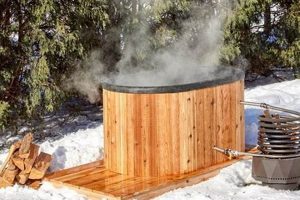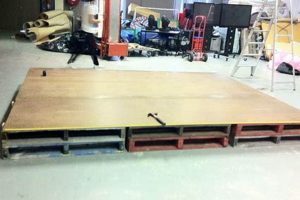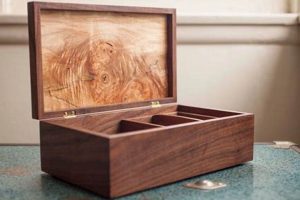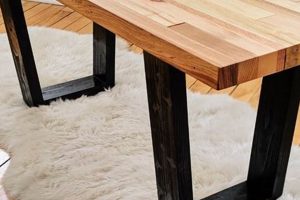Constructing work surfaces from timber, utilizing a do-it-yourself approach, represents a viable option for achieving customized aesthetics and functionality in interior spaces. These surfaces, often fabricated from hardwoods or carefully selected softwoods, require precise cutting, joining, and finishing techniques to ensure durability and longevity. For example, a homeowner might select maple for its inherent hardness and resistance to wear in a kitchen setting, applying a sealant to protect against moisture and staining.
The appeal of creating these surfaces stems from several key factors. Cost-effectiveness is often a significant driver, as purchasing raw materials and applying personal labor can result in substantial savings compared to professionally installed alternatives. Moreover, the process allows for complete control over design and dimensions, enabling the creation of truly unique and bespoke elements tailored to specific spatial requirements. Historically, woodworking skills were essential for home construction, and this approach revives that tradition, empowering individuals to enhance their living environments.
This article will delve into the essential considerations for undertaking such a project. Topics will encompass material selection, encompassing wood species and sourcing; necessary tools and equipment; step-by-step construction methodologies, including cutting, joining, and sanding; and finishing techniques to ensure a durable and aesthetically pleasing result. Crucial safety precautions will also be addressed, providing a comprehensive guide for achieving successful outcomes.
Essential Guidance for Timber Work Surface Construction
The following recommendations provide critical insights for individuals undertaking the construction of custom timber work surfaces, emphasizing best practices for achieving durable, aesthetically pleasing, and functional results.
Tip 1: Material Selection is Paramount: Prioritize hardwoods such as maple, oak, or walnut for areas subject to heavy use or moisture exposure. Softwoods, while more economical, necessitate rigorous sealing to prevent water damage and indentation.
Tip 2: Accurate Measurement and Cutting: Employ precision measuring tools and techniques. Ensure cuts are square and accurate to minimize gaps during assembly. A miter saw and table saw are highly recommended for achieving professional results.
Tip 3: Joint Integrity is Crucial: Select appropriate joinery methods based on the wood thickness and intended load. Options include biscuit joints, mortise and tenon, or pocket-hole screws, each offering varying degrees of strength and aesthetic appeal.
Tip 4: Sanding for a Smooth Finish: Begin with a coarse grit sandpaper (80-100) and progressively increase to finer grits (180-220) to achieve a consistently smooth surface. Proper sanding eliminates imperfections and ensures optimal adhesion of the chosen finish.
Tip 5: Sealing Against Moisture Intrusion: Apply multiple coats of a high-quality sealant, such as polyurethane or epoxy resin, to protect the wood from water damage, staining, and bacterial growth. Ensure adequate ventilation during application.
Tip 6: Proper Support Structure: Design and implement a robust support structure to prevent sagging or warping, especially for long or wide surfaces. Consider using steel supports for maximum stability.
Tip 7: Consider Expansion and Contraction: Wood expands and contracts with changes in humidity. Account for this by leaving small gaps around the edges of the surface during installation.
Adhering to these principles yields a durable and attractive custom timber work surface, enhancing the functionality and aesthetic appeal of the space. The resulting product represents a significant investment of time and effort, necessitating meticulous attention to detail throughout the construction process.
The subsequent sections will address specific finishing techniques and maintenance strategies, further ensuring the longevity and beauty of the completed project.
1. Material Selection
Material selection forms the foundational basis for any successful do-it-yourself timber work surface project. The chosen species dictates not only the aesthetic appearance but also the durability, maintenance requirements, and overall longevity of the finished installation. Careful consideration must be given to the intended use, environmental conditions, and budget constraints to ensure a suitable match between material and application.
- Hardness and Durability
The Janka hardness rating is a primary indicator of a wood’s resistance to denting and wear. High-traffic areas, such as kitchens, benefit from harder species like maple, oak, or walnut. Softer woods, such as pine or fir, are more susceptible to damage but can be suitable for low-use areas or applications where a rustic aesthetic is desired. A lower rating can mean more frequent refinishing or susceptibility to damage.
- Moisture Resistance
Wood’s natural susceptibility to moisture dictates the need for species with inherent resistance or the implementation of robust sealing measures. Species like teak or cedar possess natural oils that repel water, making them suitable for areas with high humidity or potential water exposure. Other woods require thorough sealing with waterproof finishes to prevent warping, cracking, or fungal growth. Failure to properly seal can lead to decay and structural failure.
- Aesthetic Characteristics
Wood grain, color, and texture contribute significantly to the overall aesthetic appeal. Species such as cherry or walnut offer rich, dark tones and distinctive grain patterns, while maple provides a lighter, more uniform appearance. The choice should complement the surrounding decor and personal preferences. Consideration should also be given to the ease of staining and finishing to achieve the desired visual outcome.
- Cost and Availability
The cost of different wood species varies significantly depending on availability, harvesting practices, and processing requirements. Exotic hardwoods are typically more expensive than domestically sourced varieties. Furthermore, responsible sourcing from sustainable forests should be a key consideration, promoting environmentally conscious construction practices. Balancing budget constraints with desired performance characteristics is essential for project success.
The selection of appropriate wood species, factoring in hardness, moisture resistance, aesthetic qualities, and cost, directly impacts the performance and longevity of timber work surfaces. By carefully considering these factors, individuals can create a durable, aesthetically pleasing, and functional surface that enhances the value and appeal of their living space. Therefore, informed material decisions are non-negotiable for do-it-yourself projects.
2. Joint Strength
The structural integrity of any timber work surface is fundamentally dependent upon the strength and durability of the joints used to connect individual components. In the context of do-it-yourself construction, proper joint selection and execution are crucial for ensuring long-term stability and preventing premature failure. Inadequate joint strength can lead to warping, cracking, or complete structural collapse under load or environmental stress.
- Joint Type Selection
The choice of joint type directly impacts the overall strength and appearance of the timber surface. Butt joints, while simple, offer minimal resistance to stress and require additional reinforcement. Lap joints provide increased surface area for gluing and mechanical fastening, enhancing strength. Mortise and tenon joints, known for their exceptional strength and durability, are suitable for high-stress applications. Dovetail joints offer both strength and an aesthetically pleasing appearance. The appropriate selection depends on the specific load requirements, aesthetic preferences, and skill level of the builder. For example, a large island surface will require stronger joints than a small vanity top.
- Adhesive Application
Adhesive plays a vital role in reinforcing joints and preventing movement. High-quality wood glue, specifically formulated for interior or exterior use, should be applied generously and evenly to all mating surfaces. Proper clamping pressure is essential to ensure optimal adhesion and prevent gaps. Insufficient glue or inadequate clamping can result in weak joints that are prone to failure. It is essential to clean any excess glue that squeezes out of the joint as dried glue can inhibit the finish. The application of the adhesive should be done according to the manufacturer’s instructions.
- Mechanical Fasteners
Mechanical fasteners, such as screws, nails, or dowels, provide additional reinforcement to joints, particularly in situations where adhesive alone is insufficient. The type and size of fastener should be appropriate for the wood species and joint configuration. Screws offer superior holding power compared to nails, while dowels provide a clean, concealed connection. Proper spacing and alignment of fasteners are crucial to prevent splitting or weakening of the wood. Using a pilot hole prevents wood from splitting and increases the holding power of the fastener. A combination of adhesive and mechanical fasteners is often the most effective approach to ensuring joint strength.
- Wood Movement Considerations
Wood naturally expands and contracts with changes in humidity. Joint design must accommodate this movement to prevent stress and cracking. Allowing for slight gaps in joints or using flexible adhesives can mitigate the effects of wood movement. Rigidly fixed joints that restrict movement are more prone to failure over time. Consideration of wood grain direction is important. Grain direction perpendicular to the joint line can increase the risk of splitting as the wood expands and contracts. This movement of wood is essential to consider to avoid joint failure. Careful design allows for the natural properties of wood.
The interplay between joint type, adhesive application, mechanical fasteners, and wood movement considerations directly influences the long-term performance of timber work surfaces. Inadequate joint strength can compromise the structural integrity and aesthetic appeal, leading to costly repairs or replacements. Therefore, a thorough understanding of joint principles and meticulous execution are essential for successful outcomes in do-it-yourself wood countertop construction. Achieving robust joints is integral to the project’s overall success.
3. Surface Finish
The surface finish applied to do-it-yourself timber work surfaces represents a critical determinant of the installation’s long-term performance, aesthetic appeal, and hygienic properties. The selection and application of a suitable finish directly influence the wood’s resistance to moisture penetration, staining, abrasion, and bacterial growth. For example, a poorly applied finish, or one lacking adequate protective properties, can result in water damage, discoloration from spills, and the proliferation of harmful microorganisms, especially in kitchen or bathroom settings. The choice of finish, therefore, acts as a primary defense against environmental stressors and daily wear and tear.
Several types of finishes are commonly employed in timber work surface applications, each possessing distinct characteristics and suitability for specific use cases. Polyurethane finishes offer exceptional durability and water resistance, making them well-suited for high-traffic areas and surfaces prone to moisture exposure. Oil-based finishes, such as tung oil or linseed oil, penetrate the wood, enhancing its natural beauty and providing a soft, matte appearance. However, oil-based finishes typically require more frequent maintenance and offer less protection against scratching and staining. Water-based finishes provide a low-VOC alternative with good durability and ease of application. The choice of finish must align with the intended use of the work surface and the desired aesthetic outcome. Proper surface preparation, including thorough sanding and cleaning, is essential for achieving optimal adhesion and a uniform finish. Insufficient preparation can result in uneven coverage, peeling, or bubbling, compromising the protective qualities of the finish.
Ultimately, the surface finish is not merely a cosmetic enhancement but an integral component of a do-it-yourself timber work surface. A well-selected and properly applied finish extends the lifespan of the installation, preserves its aesthetic appeal, and ensures a hygienic surface for food preparation or other activities. Neglecting this aspect can lead to premature deterioration, increased maintenance requirements, and potential health risks. The selection of appropriate materials and the application of proper techniques should be considered an investment in the surface’s long-term success. The finish protects the underlying wood and provides aesthetic value.
4. Sealing Integrity
Sealing integrity represents a cornerstone of longevity and performance in do-it-yourself timber work surface construction. It dictates the ability of the constructed surface to withstand environmental stressors, resist damage from liquids, and maintain hygienic standards. A compromised sealant layer can lead to rapid deterioration of the wood, fostering microbial growth and rendering the surface unsuitable for its intended purpose.
- Barrier Against Moisture Intrusion
An effective sealant acts as a physical barrier, preventing water and other liquids from penetrating the wood fibers. Moisture intrusion promotes swelling, warping, and cracking, ultimately compromising the structural integrity of the surface. For instance, in kitchen environments, repeated exposure to water from spills or cleaning can rapidly degrade an unsealed or poorly sealed timber surface, leading to irreversible damage. Proper sealing prevents these issues.
- Resistance to Staining and Discoloration
Sealants prevent staining and discoloration by creating a protective layer that prevents liquids from reacting with the wood’s natural tannins and pigments. Without adequate sealing, substances like coffee, wine, or fruit juices can permanently stain the surface, detracting from its aesthetic appeal. A well-sealed timber surface allows for easy cleanup and maintains its original color and appearance over time, preserving its aesthetic value.
- Inhibition of Microbial Growth
Sealing wood surfaces creates an inhospitable environment for microbial growth, including bacteria and mold. Porous, unsealed wood provides a breeding ground for these organisms, posing a potential health risk, especially in food preparation areas. A properly sealed surface, particularly with antimicrobial additives, minimizes the risk of contamination and promotes a hygienic environment. This is particularly important in spaces where food preparation occurs.
- Enhancement of Finish Durability
The sealant layer provides a foundation for the applied finish, enhancing its durability and resistance to abrasion. A properly sealed surface allows the finish to adhere more effectively, increasing its lifespan and reducing the need for frequent reapplication. The sealant protects the wood, and the finish protects the sealant. An integrated system is optimal for the surface’s appearance and longevity. A strong seal is key to a durable, long-lasting wood surface.
Sealing integrity is not merely an optional step but a fundamental requirement for successful do-it-yourself timber work surface projects. The implementation of appropriate sealing techniques directly correlates with the long-term performance, hygienic properties, and aesthetic appeal of the finished installation. Neglecting this aspect undermines the entire project, leading to premature failure and potential health hazards. A commitment to proper sealing is essential for a durable and attractive work surface.
5. Support Structure
The structural framework underpinning a do-it-yourself timber work surface dictates its long-term stability, load-bearing capacity, and resistance to deformation. Insufficient support can lead to sagging, warping, and eventual failure of the surface, regardless of the quality of the timber or finish used. Consequently, a robust and appropriately designed support structure is paramount for a successful installation.
- Load Distribution and Span
The support structure must effectively distribute the anticipated load across the entire surface area. The span, or distance between support points, directly influences the required strength and stiffness of the supports. Longer spans necessitate stronger materials and closer spacing of supports to prevent deflection under load. For example, a kitchen island constructed with a wide unsupported span will require substantial reinforcement compared to a narrow countertop supported by cabinets at close intervals. Inadequate load distribution results in concentrated stress, leading to premature failure.
- Material Selection for Supports
The choice of material for the support structure significantly impacts its load-bearing capacity and resistance to environmental factors. Wood, steel, and engineered wood products are commonly used. Steel offers superior strength and rigidity, making it suitable for long spans and heavy loads. Wood provides a more traditional aesthetic and is easier to work with but may require additional reinforcement for larger surfaces. Engineered wood products, such as plywood or laminated veneer lumber (LVL), offer a balance of strength and dimensional stability. The selected material should be compatible with the surrounding environment and resistant to moisture, corrosion, and insect infestation. Incorrect material selection can lead to structural compromise.
- Attachment Methods and Stability
The method of attaching the timber work surface to the support structure influences its overall stability. Secure and rigid connections are essential to prevent movement and shifting. Screws, bolts, and adhesive are commonly used to attach the surface to the supports. The fasteners should be appropriately sized and spaced to distribute the load evenly. Inadequate attachment can lead to instability and eventual separation of the surface from the supports. A robust attachment is essential for the surface’s longevity.
- Accounting for Wood Movement
Timber expands and contracts with changes in humidity. The support structure design must accommodate this movement to prevent stress and cracking. Allowing for slight gaps between the surface and the supports, or using flexible attachment methods, can mitigate the effects of wood movement. Rigidly fixed connections that restrict movement are more prone to failure over time. Failure to account for wood movement can cause surface distortion and joint separation.
The support structure serves as the unseen foundation for do-it-yourself timber work surfaces, influencing their stability, load-bearing capacity, and longevity. A well-designed and properly constructed support system, incorporating appropriate load distribution, material selection, attachment methods, and accommodation for wood movement, is indispensable for a successful and durable installation. Without proper planning, the DIY timber work surface can easily collapse
6. Dimensional Stability
Dimensional stability, concerning do-it-yourself timber work surfaces, denotes the ability of the wood to maintain its original dimensions and shape despite fluctuations in environmental conditions, particularly humidity and temperature. This characteristic directly influences the long-term performance and aesthetic integrity of installations. Instability manifests as warping, cupping, twisting, or cracking, compromising the surface’s functionality and visual appeal. For example, a wide timber countertop installed in a kitchen with significant humidity swings may experience cupping, rendering it uneven and unsuitable for food preparation.
Achieving dimensional stability in such projects requires careful material selection and construction techniques. Species with low shrinkage coefficients, such as mahogany or quarter-sawn hardwoods, exhibit greater resistance to dimensional changes than woods like pine or plain-sawn lumber. Kiln-drying lumber to a moisture content appropriate for the installation environment is critical. Proper sealing with moisture-resistant finishes further minimizes moisture absorption and loss. Employing joinery methods that accommodate wood movement, such as floating joints or breadboard ends, prevents stress buildup and subsequent warping. Neglecting these considerations invariably results in surface distortion and joint separation, necessitating costly repairs or replacements.
In summary, dimensional stability is a non-negotiable factor in the creation of durable and aesthetically pleasing timber work surfaces. A comprehensive understanding of wood properties, coupled with appropriate material selection, construction techniques, and finishing practices, is essential for mitigating the detrimental effects of environmental fluctuations. Prioritizing dimensional stability safeguards the investment of time and resources, ensuring a functional and visually appealing surface for years to come. Failing to account for these properties is a common mistake in DIY projects, often leading to early failure.
7. Cost Effectiveness
The economic feasibility of constructing work surfaces from timber, employing a do-it-yourself approach, constitutes a significant consideration for many individuals. The degree to which this method yields cost savings is contingent upon various factors, including material selection, tool availability, and the level of pre-existing woodworking skills possessed by the individual.
- Material Sourcing and Procurement
Direct procurement of lumber from mills or wholesalers can substantially reduce material costs compared to purchasing pre-fabricated countertops from retail outlets. Salvaged or reclaimed timber offers an even more economical, albeit potentially labor-intensive, option. However, the cost savings associated with reclaimed materials must be weighed against the time and effort required for processing and preparation, including removing old finishes, hardware, and potential contaminants. The initial savings may diminish due to added labor or specialized tools.
- Labor Investment and Skill Requirements
The do-it-yourself approach necessitates a significant investment of personal labor. The extent of this investment is directly proportional to the complexity of the design and the individual’s proficiency in woodworking. Individuals lacking experience may require more time and resources to achieve satisfactory results, potentially negating some of the initial cost savings. Furthermore, errors resulting from inexperience can lead to material waste and the need for rework, increasing overall project expenses. A realistic assessment of one’s skill level is paramount.
- Tool Acquisition and Depreciation
Successful construction of timber work surfaces typically requires a range of specialized tools, including saws, planers, sanders, and finishing equipment. If these tools are not already available, their acquisition represents a significant upfront investment. While the cost of these tools can be amortized over multiple projects, it must be factored into the overall cost assessment. Rental options may provide a more cost-effective alternative for individuals undertaking only a single project. Tool maintenance also adds cost.
- Finishing and Sealing Materials
The selection of appropriate finishing and sealing materials directly impacts the long-term durability and maintenance requirements of the timber work surface. While lower-cost finishes may offer initial savings, they often provide inadequate protection against moisture, staining, and abrasion, leading to premature deterioration and the need for frequent reapplication. Investing in high-quality finishes, despite their higher initial cost, can result in long-term cost savings by extending the lifespan of the installation and reducing maintenance expenses. Choosing the correct finish is essential for cost-effectiveness
The economic advantages associated with constructing timber work surfaces using a do-it-yourself methodology are contingent upon careful planning, realistic assessment of skill levels, and prudent material selection. While the potential for cost savings is undeniable, it is essential to consider all relevant expenses, including materials, tools, labor, and finishing, to ensure a truly cost-effective outcome. Furthermore, the long-term maintenance costs must be factored into the equation to provide a comprehensive assessment of the economic feasibility of this approach. The total cost should not only be less but also be long-lasting.
Frequently Asked Questions
The following questions address common concerns and misconceptions regarding the fabrication and installation of work surfaces from solid wood. The answers aim to provide clarity and guidance for individuals considering this project.
Question 1: Which wood species is most suitable for kitchen countertops?
Hardwoods such as maple, oak, and walnut offer superior resistance to wear and moisture compared to softwoods like pine. Maple, in particular, is frequently recommended due to its density and closed grain, which minimize water absorption. However, the appropriate wood choice also depends on desired aesthetic and budget constraints.
Question 2: Is sealing a timber countertop truly necessary?
Sealing is not merely recommended but rather an essential step in preserving the integrity of any wood work surface exposed to moisture or liquids. The sealant protects the wood from water damage, staining, and bacterial growth. Failure to seal adequately can lead to irreversible damage and potential health hazards.
Question 3: What is the best type of finish to use on a wood countertop?
The selection of the ideal finish depends on the intended use. Polyurethane finishes offer excellent water resistance and durability, making them suitable for kitchens and bathrooms. Oil-based finishes enhance the natural beauty of the wood but require more frequent maintenance. Water-based finishes provide a low-VOC alternative with good performance characteristics.
Question 4: How can warping be prevented in a wood countertop?
Warping is primarily caused by uneven moisture absorption or loss. Using kiln-dried lumber, properly sealing all surfaces, and allowing for wood movement during installation are crucial preventative measures. Reinforcing the countertop with a robust support structure further minimizes the risk of warping, especially for wider surfaces.
Question 5: How can scratches and dents be repaired on a wood countertop?
Minor scratches can often be buffed out with fine-grit sandpaper and refinished. Deeper dents may require steaming to raise the wood fibers or filling with a wood filler before sanding and refinishing. Regular maintenance and the use of cutting boards can help prevent significant damage. Preventative action is always better.
Question 6: What is the best way to clean a wood countertop?
Avoid harsh chemicals and abrasive cleaners, which can damage the finish. A mild soap and water solution is generally sufficient for routine cleaning. Wipe up spills promptly to prevent staining. Periodically applying a wood conditioner can help maintain the moisture content and prevent drying and cracking.
Understanding these key principles of construction and maintenance ensures the longevity and appeal of surfaces created from wood.
The next section will focus on specific techniques for ensuring the durability of installations.
Conclusion
The preceding exploration of DIY wood countertops underscores the critical balance between aesthetic aspirations and practical considerations. Key points include species selection, joint integrity, appropriate sealing techniques, and the necessity of a robust support structure. Ignoring these factors inevitably leads to compromised performance and a diminished lifespan of the installed surface.
Ultimately, the successful implementation of a DIY wood countertop project demands a thorough understanding of woodworking principles and a commitment to meticulous execution. While the allure of personalized design and potential cost savings is undeniable, potential constructors should carefully weigh their skill level and available resources against the inherent challenges. The durability and visual appeal of the final product hinge on this critical assessment, ensuring a lasting investment rather than a short-lived endeavor.



![[DIY Guide] Easy DIY Wood Window Shutters You Can Build! The DIY Hub: Creative Crafts, Repairs & Life Hacks [DIY Guide] Easy DIY Wood Window Shutters You Can Build! | The DIY Hub: Creative Crafts, Repairs & Life Hacks](https://craftingdiycenter.com/wp-content/uploads/2025/07/th-3579-300x200.jpg)



